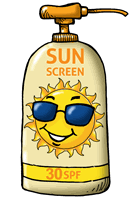Sun Safety
Fun in the Sun—the Safe Way!

Going outdoors is a great way to get active and have fun, but it’s important to stay sun-safe!
You don’t have to be at the pool, at the beach, or on vacation to get too much sun. Protecting yourself from the sun’s rays is important whenever you’re outside.
The Science Behind the Sun
The sun gives off light in the form of ultraviolet radiation, or UV rays. UV rays are harmful to your body because they can cause damage to your skin, and even your eyes, if proper protection is not used. Although UV rays mostly come from the sun, they are also emitted by some machines, like tanning beds.
The Earth is wrapped in a blanket of air called the ‘atmosphere,’ which is made up of several layers. A layer of gas that is 19-30 kilometers above the Earth is called the ozone, which is a form of oxygen. The Earth’s ozone layer is important because it stops too many of the sun’s UV rays getting through to the Earth. Many of them still get through and these rays can cause our skin to tan. Too much UV rays can damage your skin, which is why getting too much sun can cause a sunburn. Over time, spending too much time in the sun without protection can also lead to early skin aging like wrinkles and age spots, eye problems, and even skin cancer. It’s easy to see why sun safety is so important!
Weather cool and rainy? Don’t be fooled by cloudy skies or cool temperatures! It’s still important to keep protecting yourself from the sun. The sun’s UV rays can pass through clouds, and that’s what can do damage, not the temperature.
Keep in mind that when the sun’s UV rays hit the earth’s surface, they don’t just stay put. UV rays can bounce off of surfaces like sand, water, and even snow. This is why it takes extra work to avoid getting sunburned when you’re at the beach, the pool, or even on the ski slopes.
Plan Ahead with the UV Index!
The intensity of the sun’s UV rays depend on many different factors. The sun’s UV rays are strongest:
- During midday
- Near the equator
- During the summer months
- At high altitudes
One easy way to plan ahead before going outdoors is to check the strength of the sun’s rays where you live using the UV index.
The UV index is an online tool that predicts how strong the sun’s UV rays are each day, on a scale from 0 to 11+. A lower UV index means fewer UV rays are reaching the earth’s surface and you are less likely to get sun damage while outside. A higher UV index means you will need more sun protection to keep your skin and eyes safe. At nighttime, when it is dark outside, the UV index will be 0.
Check out the UV index in your area by entering your ZIP Code or the name of your city and state to find out how strong the UV rays are in your favorite outdoor spots!
Tanning—Beware!
A tan is actually a response to injury from the sun. It’s your skin’s way of trying to protect itself from further damage. When exposed to UV rays, your skin makes a pigment, or color, called melanin, which gives skin a tanned appearance.
Some people use tanning beds to get tan. This is called indoor tanning. Tanning beds give off powerful levels of UV rays.
It’s best to avoid indoor tanning altogether because every time you tan, you increase your risk of getting skin cancer, as well as, other types of skin damage like wrinkles and age spots (flat, brown, gray, or black spots on the skin).
Sunless tanning lotions, sprays, and wipes use a chemical called dihydroxyacetone, or DHA, to give your skin a tanned look. If you decide to use a sunless tanning product, be careful not to accidentally inhale it or let it get in your eyes, nose, mouth, or ears.
Sometimes, you might feel pressure from the media (Facebook, Instagram, movies, or TV), friends, or even family members to change the natural appearance of your skin and get a more tanned look. It’s important to remember that healthy skin is beautiful skin, and your natural skin tone is what makes you uniquely you!
Sun Protection Done Right
Get a hat. Grab a wide-brimmed hat to shade your face, head, ears, and neck. If you are wearing a baseball cap, be sure to put sunscreen on your ears and the back of your neck.

Wear sunglasses. Sunglasses aren’t just for looks! Sunglasses protect your eyes from the sun’s rays, and keep your eyes healthy and your vision sharp. Look for sunglasses that wrap around and block as close to 100% of the sun’s rays as possible. This information can often be found directly on the sunglasses.

Apply sunscreen. Put sunscreen on any exposed skin about 15 minutes before going outside to make sure you are totally protected. Don’t forget that sunscreen wears off. You’ll need to reapply it every two hours and after swimming, sweating, or drying off with a towel. To be sure the sunscreen will give you the protection you need, check the label to make sure it has a Sun Protection Factor (SPF) of at least 15 and is labeled as broad spectrum.
Cover up. Your clothes can provide great protection from the sun. Long-sleeved shirts, pants, and long skirts offer the best protection. If wearing this type of clothing isn’t practical, at least try to wear a t-shirt or a beach cover-up. Darker colored clothing is usually more protective than lighter colors, and a wet shirt is less protective than a dry one. Keep in mind that a typical t-shirt has an SPF rating lower than 15, so use other types of protection as well.
Seek shade. You can also help protect your skin by seeking shade. The sun’s rays are strongest during the middle of the day, from about 10 am to 4 pm. This is a good time for indoor activities. But if you are going to be outside during midday, try to stay in the shade as much as possible—under a tree, an umbrella, or any covered area out of the sun.
For greatest protection, use more than one way to protect yourself from the sun, use a combination of methods, such as shade, clothing, a hat with a wide brim, sunglasses, and sunscreen.
Too Much Sun Hurts
Unprotected skin can be damaged by the sun’s UV rays in as little as 15 minutes, but it can take up to 12 hours for skin to show the full effect of sun exposure. If you already feel like you may have a sun burn, it’s time to get out of the sun to avoid any more damage to your skin!

Starting to develop a tan? There’s no other way to say it—sun-tanned skin is damaged skin. Any change in the color of your skin after time outside—whether sunburn or suntan—shows damage from UV rays.
No matter what your skin color, it’s important to protect your skin. There are three things that determine whether people burn or tan: 1.) Skin type (normal, dry, oily, or combination 2.) Time of the year 3.) How long they have been unprotected by the sun’s UV rays.
Over time, too much exposure to UV rays can change how your skin feels, making it peel and dry. It can even cause your skin to age faster than normal, leading to wrinkles and dark patches. Sometimes, it can also cause skin cancer.
Your skin isn’t the only thing that can burn from the sun. Your eyes can get sunburned too, making them red, dry, and painful, with a rough scratchy feeling. Too much sun can cause long-lasting damage to your eyes, including vision problems, making it harder to see.
People often get too much sun accidentally, when they are outdoors unprotected for longer than expected. Remember to plan ahead, and keep sun protection like clothing, hats, and sunscreen handy in a bag or backpack.
Ouch! What Do I Do if I Get a Sunburn?
You can’t always see a sunburn immediately after sun exposure. Symptoms of a sunburn usually start about four hours after being in the sun, become worse in 24–36 hours, and go away in three to five days.
If you get a sunburn, your skin may look red or pink, feel tender and swollen, and can develop painful blisters. Other symptoms may include headache, fever, nausea, and fatigue.
To reduce the symptoms of a sunburn:
- Drink plenty of water to help replace any fluids lost
- Comfort burns with a cool bath or by gently applying a cool, wet cloth to the burned area
- Avoid further exposure to the sun until the burn has gone away completely
- Apply moisturizing cream, such as aloe or 1% hydrocortisone cream, to provide additional relief
If blistering occurs:
- Lightly bandage or cover the area with gauze (loosely woven cotton bandage) to prevent infection
- Do not break the blisters—this slows healing and increases the risk of infection, making the blister even worse
- When the blisters break on their own and the skin peels, the dried pieces of skin can be removed and medicine or moisturizing cream can be applied for extra relief
Vitamin D
Your body needs vitamin D to absorb calcium so you can develop strong bones, muscles, and teeth. Even though your body makes vitamin D when your skin is exposed to the sun, you can also get the vitamin D your body needs from foods like fish, milk, and eggs as well as from a daily multivitamin, if you take one. Try to get most of your vitamin D from the foods you eat rather than from the sun to keep your skin and your bones healthy.
Facts vs. Myths About Sun Safety
Myth: Sun protection is just for the beach or pool.
Fact: Sun protection is always important when spending time outdoors, even when doing everyday activities like playing sports or going for a bike ride.
Myth: Skin tanned from the sun or tanning beds is healthy skin.
Fact: Whether tanning or burning, you are exposing yourself to UV rays that damage your skin. In fact, every time you tan or burn, you increase your risk of skin cancer.
Myth: Sun protection is only for those with light skin.
Fact: Although lighter skin is more sun-sensitive, anyone’s skin can be damaged by the sun. Sun protection is important for all skin colors and types.
Myth: Cloudy or cool weather means that you can skimp on sun protection.
Fact: You can get sun damage even on cloudy and cool days. The best way to know how much protection you need is to check the UV Index.
Myth: A “base tan” is a safe tan.
Fact: A tan is a sign of skin damage and provides little protection against future damage from the sun or indoor tanning.
Myth: Tanning indoors is safer than tanning in the sun.
Fact: UV rays from tanning beds can be even stronger than the sun exposure you would get outside. Whether indoors or outdoors, tanning exposes your skin to UV rays, increasing your risk for skin cancer and premature skin aging.
Myth: You need a tan to look your best!
Fact: Embrace your natural skin color, and rock a look that’s uniquely YOU!
- Page last reviewed: July 24, 2017, 02:15 PM
- Page last updated: July 24, 2017, 02:15 PM
- Content source:



 ShareCompartir
ShareCompartir